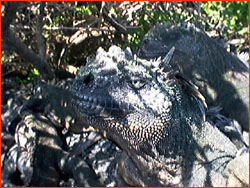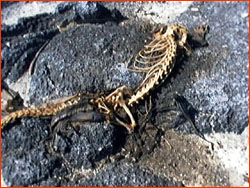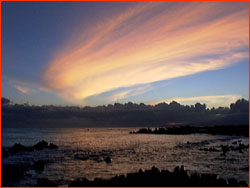
|

|

|
Editor's Note: The following dispatch was written on February 17, but received on February 20, due to communications difficulties. For more on that subject, see Transmitting from a Fish Bucket.A Slow Poach February 17, 1998 By Mark Hoover previous | next I've just finished a day that was about as full—of images, discoveries, and revelations—as a day can possibly be. I'm sweating, ruing my sunburned shoulders, and I can't wait for more. Once again, I find myself typing away in the dark. It's the only quiet time of the day on a small boat with 12 other people aboard. I'm having some trouble with the computer tonight, but I think it's due to the heat. The author Jonathan Weiner commented that El Niño happens when the Pacific Ocean runs a fever. Here at Ground Zero is where a lot of that feverish heat is released back into the atmosphere. The ocean does not refresh you when you swim in it; it feels like it's the same temperature as your own body. I understand now how its heat can affect many of the creatures that inhabit it. Call it a slow poach. We are at anchor, in a narrow channel separating two islands, surrounded on both sides by the rising masses of volcanoes that ascend a mile into the atmosphere. To the west on Isabella is Volcán Darwin, and to the east, on Fernandina, is Volcán Lacumbre. As Fernando, our naturalist, explains it, island building is going on here following much the same model as is found in Hawaii: lots of slow-motion eruptions that release floods of low-viscosity lava that flow like chilled syrup over the hardened surface of the previous eruption. The Galapagos, says Fernando, are among the most active island volcanic groups in the world. Because the islands are only a few million years old, they have not had time to wear down much, except along the shore, where the waves cut the soft volcanic rock into terraces. The Galapagos sit over a "hot spot" deep in the mantle, which injects magma through the overlying crust with regularity, and renew the surface. The last eruption was in 1995, very near our mooring point on Fernandina. I ask Mike if there's anything to the idea that undersea volcanism contributes to El Niño. He smiles, and it's clear this isn't the first time he's been asked. "There's a principle in science called Occam's Razor, dating back to William of Occam, a philosopher in the 13th century who battled it out with Thomas Aquinas. A lot of scientists invoke it, including me. The idea is, the simpler the explanation for something, the more likely it is to be right. I can explain El Niño using only the interactions between the atmosphere and the ocean. I don't need a volcano to help out." (See the FAQ section for more discussion on this topic) We've had to travel all night through a rolling sea to get here by morning. I never realized how much territory the Galapagos Islands consume; by boat, which is your only option, it can take days to traverse from one end of the range to the other. As we passed around the northern point of Isabella late last night, I watched the wake of our boat. A bioluminescent alga inhabits the water, and when it is stirred up by the boat's passage, something stimulates the release of a blue spark of light. The effect is mesmerizing. As the boat slices through the black water, it is illuminated from below by what seems a cascade of tiny underwater meteors. A turbulent pale blue contrail marks our passage in the waters behind us. These warm-water algae are not common in the cold upwelling that usually surrounds the islands, and Mike McPhaden is surprised. "This is something you usually only see far west of here." Mike has cruised to most of the mooring points of the TOGA/TAO buoy array, which stretches from here almost to Australia, so he should know.  We are here to examine El Niño in the context of the
creatures who inhabit these islands, to observe its effects on
them, and to gather with our own eyes, noses, and fingers
information that cannot be gotten from a book. Mike, our
scientist-in-residence, and our Ecuadorian naturalists Froylan
and Fernando, are especially excited by the morning's
junket—a trip to Punta Espinosa, where a spit of rock
leads to a weird rust-colored moonscape of pahoehoe lava,
riddled by giant cracks and fissures, and dotted with tidal
pools. Pahoehoe is a Hawaiian word referring to lava with a
relatively smooth, curtain-like surface that sometimes
involutes, or folds over on itself, in great sheets. It is the
lava of Mauna Loa. This is prime territory for the marine
iguana, a docile vegetarian with protective spikes, black lips
and a dinosaur's vaguely evil mien. Yet these peaceful
creatures dine only on a seaweed found in abundance here, a
seaweed that cannot tolerate sudden changes in the temperature
of the sea. During the disastrous 1982 El Niño, more
than half of these ancient lizards perished, and those that
didn't looked markedly thin. We are anxious to know their fate
this year.
We are here to examine El Niño in the context of the
creatures who inhabit these islands, to observe its effects on
them, and to gather with our own eyes, noses, and fingers
information that cannot be gotten from a book. Mike, our
scientist-in-residence, and our Ecuadorian naturalists Froylan
and Fernando, are especially excited by the morning's
junket—a trip to Punta Espinosa, where a spit of rock
leads to a weird rust-colored moonscape of pahoehoe lava,
riddled by giant cracks and fissures, and dotted with tidal
pools. Pahoehoe is a Hawaiian word referring to lava with a
relatively smooth, curtain-like surface that sometimes
involutes, or folds over on itself, in great sheets. It is the
lava of Mauna Loa. This is prime territory for the marine
iguana, a docile vegetarian with protective spikes, black lips
and a dinosaur's vaguely evil mien. Yet these peaceful
creatures dine only on a seaweed found in abundance here, a
seaweed that cannot tolerate sudden changes in the temperature
of the sea. During the disastrous 1982 El Niño, more
than half of these ancient lizards perished, and those that
didn't looked markedly thin. We are anxious to know their fate
this year.Part of the camera crew got up early this morning to shoot underwater sequences in a place off Isla Fernandina favored by turtles. The television show next fall will discuss the effects of El Niño on the green sea turtle, and our diving advisor and naturalist Fernando was up before dawn getting things ready. He's lived here a dozen years, but you'd think he got here yesterday, to judge by his enthusiasm. The population of the entire Galapagos archipelago is only 20,000, so Fernando is a member of a select community indeed. While the crew was diving, I made my own discovery of a small geyser. It periodically belched a spray of water and vile fumes into the air, and it gave me a snootful the first time I peered at it. Unfortunately, this geyser was in the bathroom sink drain on the Orca, and it was belching "tank gas" as the boat rocked in the water. Sometimes one must suffer for one's art. I decided to forego shaving. Soon we loaded the launch for the short journey to Punta Espinola. We landed in craggy place of mangroves and tidal pools. The mangroves support one of the very few mammals on the Galapagos, the Galapagos bat (the others are the rice rat, and sea lions). Although we saw no bats, we saw communities of crabs clinging to the rocks near the mangrove roots. No apparent problems there. Farther up the point, an iguana squatted in the shade of a lava fissure. He was not alone. Soon it was apparent that other iguanas had claimed most of the shady places in the rocks around us. As we tread the broken stone and hardened lava of the path, we came across dead iguanas as well, sometimes accompanied by small lizards who picked at their bones. Victims of El Niño, or part of the natural cycle of life and death, we could not say. Fernando said that the seaweed upon which the iguanas feed had suffered, but not yet to the point of starving the iguanas. Straying from the film crew for a few minutes, I chanced across a series of pools where a small group of sea lions had taken up residence. At one end, a male and female lolled in the water, napping side by side. The males are twice the size of the females, and develop a characteristic hump on the forehead. They are also the ones who guard the pools and the young, and bark at encroachers (although usually not at humans, whom they largely ignore). A solitary female sleeps not far from the pool under a piece of driftwood, groggily opening her eyes as I bend closer for a photograph. Her tiny ears twitch, however, as the males vocalizes in the distance, and I conclude she is part of his harem.  The majority of the sea lion diet is sardines, and along the
South American coast, sea lion populations are in trouble in
direct proportion to the crash of the sardine fishery. Here in
Galapagos, there are still some sardines to eat, and sea lion
mortality has been low so far. In 1982, there was a massive
die-off, caused both by direct starvation, and by abandonment
of young.
The majority of the sea lion diet is sardines, and along the
South American coast, sea lion populations are in trouble in
direct proportion to the crash of the sardine fishery. Here in
Galapagos, there are still some sardines to eat, and sea lion
mortality has been low so far. In 1982, there was a massive
die-off, caused both by direct starvation, and by abandonment
of young.In a neighboring pool, sea lions made sport of a marine iguana, using the unfortunate reptile as the ball in a game of water polo. Flipping the lizard through the air with their noses, they seemed to delight in watching it land in the water and resolutely begin swimming again for shore, and they would wait until the lizard had almost made it ashore before launching it skyward again. After a while, they tired of this, and the unharmed iguana pulled itself from the water and retreated into a crevice. In his notebooks Charles Darwin wrote about his own iguana sport, in which, from this very spot, he repeatedly tossed an iguana out into the sea, only to watch it swim directly back to him (the shortest distance to land), so he could toss it out again, like a stick that fetches itself. As Mike says, it's curious how nature shapes the brains of creatures without predators. We reload the launch and head across the channel to Urvina, where we hope to observe Darwin's finches. Arriving an hour later, we find the landscape is utterly different from Punta Espinosa, a place of scrub trees, grasses and plenty of green undergrowth attesting to the frequent rains El Niño has brought. The finches are abundant; generally, they are net winners in El Niño years here, because the seeds they prefer are more plentiful; however, subtle changes in things like their beak and body shapes during El Niño periods shows that they carry in their genes evidence of the influence of past El Niños (<The Beak of the Finch>, listed in the <Resources> section, tells more about this remarkable phenomenon). After an hour of hiking we chance across a geochelone, whose name in Latin means "earth turtle." During El Niño years, the giant tortoises come down from their normal locations in the volcanic highlands to take up temporary residence in the lowlands. We observe the tortoise in a rare behavior: picking the desiccated meat off the bones of a dead lizard. Normally, these tortoises are vegetarians; Fernando speculates that perhaps because the tortoise is off his normal feed, so to speak, he is trying to obtain missing nutrients. After a while the tortoise plods off into the underbrush. Hiking back to shore, we perch on black boulders lining the beach. As the crew puts it, "it's time for some beauty shots." The sun is setting, and Mike points out in the high clouds above Volcán Lacumbre to the west as evidence of diversion of the winds around the landmass of the islands, like a rock deflecting the flow of a stream.  "In some ways, El Niño works on a large scale the same
way these volcanoes act on a small scale—as a deflection
in a stream. Here we see the winds curving around the
obstruction of the islands, a mile or more up. Now think on a
global scale. El Niño sits out here in the central and
eastern Pacific, and the normal flow of winds is deflected
around it. Ripples from this effect create turbulence
downstream. Now think of storms as leaves in a stream. The
storms are fluttered about by the ripples, like leaves, and
move to places they normally wouldn't go. Just ask someone
from Oregon or California."
"In some ways, El Niño works on a large scale the same
way these volcanoes act on a small scale—as a deflection
in a stream. Here we see the winds curving around the
obstruction of the islands, a mile or more up. Now think on a
global scale. El Niño sits out here in the central and
eastern Pacific, and the normal flow of winds is deflected
around it. Ripples from this effect create turbulence
downstream. Now think of storms as leaves in a stream. The
storms are fluttered about by the ripples, like leaves, and
move to places they normally wouldn't go. Just ask someone
from Oregon or California."Suddenly it is dark. We scramble to load the boat before the blackness completely overtakes us. previous dispatch | next dispatch | table of contents Anatomy of El Niño | Chasing El Niño | El Niño's Reach Dispatches | Resources | Mail | Site Map | El Niño Home Editor's Picks | Previous Sites | Join Us/E-mail | TV/Web Schedule About NOVA | Teachers | Site Map | Shop | Jobs | Search | To print PBS Online | NOVA Online | WGBH © | Updated November 2000 |